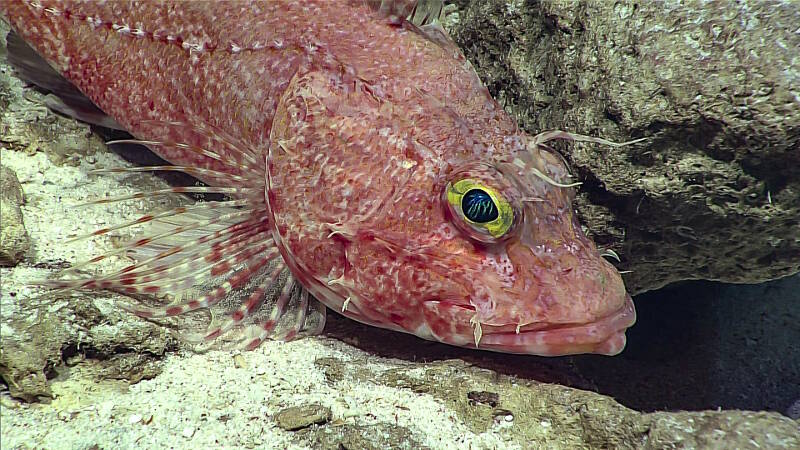
Scorpionfish resting on the seafloor at 343 meters in Rose Atoll Marine National Monument. Image courtesy of the NOAA Office of Ocean Exploration and Research, 2017 American Samoa. Download larger version (jpg, 2.3 MB).

Scorpionfish resting on the seafloor at 343 meters in Rose Atoll Marine National Monument. Image courtesy of the NOAA Office of Ocean Exploration and Research, 2017 American Samoa. Download larger version (jpg, 2.3 MB).
Dive 10: Octopus on the "Hunt"
While diving on Rose Atoll at a depth of ~700 meters, we encountered this active octopus exploring its surroundings. Video courtesy of the NOAA Office of Ocean Exploration and Research, 2017 American Samoa. Download (mp4, 30.5 MB)
Dive 10: The Hermit Crab and the Anemone
This hermit crab and its anemone associate were spotted during exploration of Rose Atoll at ~700 meters depth. Video courtesy of the NOAA Office of Ocean Exploration and Research, 2017 American Samoa. Download (mp4, 24.0 MB)
During today's dive, we explored a prominent ridge extending from the eastern region of Rose Atoll; the deeper portions of the ridge were explored during Dive 03 of the expedition. We started at a depth of ~ 700 meters and moved upslope to a depth of ~ 250 meters. For much of the dive, the seafloor was ferromanganese material that looks like basalt flows or pillow structures; however, it is also possible that the substrate is ferromanganese carbonate from a submerged reef. A range of animals were observed along this bottom, including living and dead sponges, urchins, cup corals, a mushroom coral (Anthomastus), a dandelion siphonophore, a pycnogonid sea spider, scorpion fish, deepwater cardinal fish, and eels. As Deep Discoverer moved upslope, we eventually encountered substrate dominated by smooth carbonate surfaces; dissolution of the carbonate resulted in complex and elaborate "sculptures," including nearly "hollowed out" boulders, pinnacles, and overhanging ledges. Frequently encountered animals included bamboo corals, soft octocorals and chrysogorgiid-like octocorals, small black coral colonies (Parantipathes sp?), scleractinian corals, cup corals, anemones, crinoids, and sponges. A range of fish were observed during the dive, including commercially important bottomfish such as grouper (Hypothodus octofasciatus), yellow snapper, and a school of large Etelis snapper fish.
Information from this dive will help us to better understand the diversity and structure of deep biological communities, including bottomfish and precious corals habitats, with the goal of supporting management needs of Rose Atoll Marine National Monument. Rose Atoll lies in the eastern region of the Samoan islands. Following the hotspot model, the eastern Samoan islands are predicted to be the youngest volcanic islands; however, Rose Atoll has features that suggests it is in fact quite old, calling into question Rose Atoll's relationship with the Samoan hotspot. Indeed, existing work shows that the geochemistry of dredged lavas from the deep flanks of Rose Atoll are not consistent with an origin at the Samoan hotspot. Geochemical analysis of geologic samples collected during the dive will help to discern the age and origin of Rose Atoll.